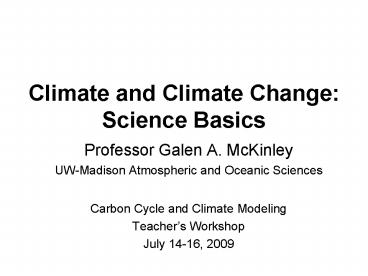Climate and Climate Change: Science Basics - PowerPoint PPT Presentation
1 / 66
Title: Climate and Climate Change: Science Basics
1
Climate and Climate ChangeScience Basics
- Professor Galen A. McKinley
- UW-Madison Atmospheric and Oceanic Sciences
- Carbon Cycle and Climate Modeling
- Teachers Workshop
- July 14-16, 2009
2
What is climate?
3
What is climate?
- Temp, pressure humidity
- Observed over a long time, not just today
- weather is what you want, climate is what you
get - Seasonal patterns of moisture
- Global-scale spatial variability
4
Where does energy come from for the climate
system?
5
The Sun
6
First Law of Thermodynamics
- dQ dU - dW
- Heat added (dQ) to a system is equal to the
change in internal energy (dU) minus the work
extracted (dW)
7
Is the Earth in energy balance?
- For now, forgetting anthropogenic climate warming
and considering long timescales .
8
From tree rings
9
Note that the Earth receives 350 W/m2 of solar
energy
- Enough energy, at all times, on every m2,
- for 3 100W lightbulbs!
10
Northern Hemisphere temperature of the past 1000
yrs
PAGES, IGBP, Ch 1
Over at least the past 1000 years, Earth has had,
to first order, quite a steady temperature
11
The Earths equilibrium is achieved through
radiative balance
12
Incoming Radiation
So1367 W/m2
Marshall and Plumb, 2003
13
Remission in Longwave governed by
Stefan-Boltzman Law
- The longwave emission by an idealized body is a
direct function of its temperature
14
At what temperature does the Earth emit?
Reflection (a0.3)
Outgoing Longwave
Earth
Incident solar
15
Ts 255K -18C?
- Much colder than what is
- observed at the surface
- (observed Ts 288K 13C)
16
Weve left off the atmosphere
17
Greenhouse Effect
18
FAQ 1.3, Figure 1
19
Earth maintains balance through radiation
GPC Fig 3.2a
Solar 99 Visible and near IR 1 UV
Earth Thermal IR
Note distinct separation. Thus, the atmosphere
can be considered both transparent to solar
radition and opaque to terrestrial radiation.
20
The atmosphere absorbs radiation
Spectra of Individual Molecules
CO2
H2O
GPC Fig 3.4
21
Combined absorption spectra and relation to
emission
GPC Fig 3.2
22
FAQ 1.3, Figure 1
23
FAQ 1.1, Figure 1
24
The climate system is more complex than just CO2
and radiation. What about the feedbacks?
25
FAQ 1.2, Figure 1
26
Positive Feedback Loops
- Example for Earth System
- Warming gt Melting of ice gt lowering albedo gt
more warming
27
Negative Feedback loops
- Example for Earth System
- Warm surface gt enhance LW emission
(Stefan-Boltzman feedback) gt cool surface
28
Stefan-Boltzman Feedback
- Key NEGATIVE feedback
- Longwave emission increases with temperature,
thus a stronger cooling at higher temperature
29
Ice Albedo Feedback
- Ice is highly reflective to incoming solar
radiation - If it melts, warming is faster because more solar
radiation is absorbed
30
Ice variations during most recent
glacial-interglacial cycle
31
(No Transcript)
32
Climate Change
33
Human beings are now carrying out a large-scale
geophysical experiment . . . . Within a few
centuries we are returning to the atmosphere and
oceans the concentrated organic carbon stored in
sedimentary rocks over hundreds of millions of
years. This experiment, if adequately
documented, may yield a far-reaching insight
into the processes determining weather and
climate. --Roger Revelle and Hans
Suess Tellus, 1957
34
Figure SPM.3
IPCC 2007
35
Temperatures of Last Millennium
36
Figure SPM.3
37
(No Transcript)
38
Lake Mendota, Madison
39
What drives the observed warming?
40
Figure SPM.1
10,000
5,000
0
Years before 2005
41
Figure SPM.1
42
Antarctic Ice Core Record
43
Antarctic Ice Core Record
44
Antarctic Ice Core Record
CH4 1756 ppb
CO2 375 ppm
45
Combined absorption spectra and relation to
emission
GPC Fig 3.2
46
FAQ 1.3, Figure 1
47
Thus, climate is changing
NASA GISS
IPCC 2007
48
Predictions with Models
Models
Predictions
Emission Scenarios
Warming of 1-6oC by 2100 emission scenario and
model dependent
49
(No Transcript)
50
What are the impacts?
- Observed and predicted
51
Global
52
Dramatic Sea Ice Decline
NASA
53
Prediction Sea ice loss continues
IPCC Fig 10.14
54
Destruction of Polar Bear Habitat and ESA
Listing Dr. Eric DeWeaver
Radio collars show preferred sea ice habitat
Climate models estimate sea ice decline as
climate warms
A USGS-led project
55
Local
56
(No Transcript)
57
Thinking about 3oC globally.
- Land warms faster than ocean
- Wisconsin, Illinois 5oC
- To Fahrenheit 9oF
- Wisconsin shifts to current-day KS/AR and
Illinois to OK/AR/TX - 3oC globally means large local changes
Shifts climate zone dramatically
58
Recent Precipitation Trends (Madison) Dr. Steve
Vavrus, CCR
59
Prediction More Extreme Precipitation Events
Wisconsin
60
This is all driven by carbon
- What is the state of the carbon cycle?
- What are the unknowns?
61
Atmospheric CO2 Concentration
Year 2007 Atmospheric CO2 concentration 383
ppm 37 above pre-industrial
1970 1979 1.3 ppm y-1 1980 1989 1.6 ppm
y1 1990 1999 1.5 ppm y-1
2000 - 2007 2.0 ppm y-1 2007 2.2 ppm
y-1
Data Source Pieter Tans and Thomas Conway,
NOAA/ESRL
62
Global Carbon Budget 2000-2007 Global Carbon
Project
1.5 Pg C y-1
Canadell et al. 2007, PNAS (updated)
63
Current emissions are greater than worst-case
scenarios in IPCC 2007
Raupach et al. 2007
64
Trend - more carbon stays in atmosphere
Ocean Land
Canadell et al. 2007
65
May be partially due to a declining ocean carbon
sink
Atmospheric increase 1.6 uatm/yr
uatm/yr
LeQuere et al., 2008, unpublished
66
(No Transcript)






























